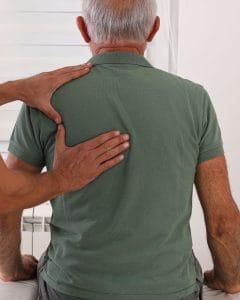
By Dr. Abigail Lindo, Registered Physiotherapist
How Treating the Whole Person Can Improve Recovery and Wellbeing
In recent years, there has been a growing interest in treating health problems by looking at the bigger picture, rather than just focusing on symptoms. This way of thinking is becoming more common in physiotherapy and osteopathy, where many practitioners now use holistic health approaches. These methods aim to treat the whole person – not just the painful area- by considering how everything in the body and mind is connected.
What Does Holistic Health Mean?
Holistic health is all about seeing the body and mind as one system. It means looking at physical, emotional, mental and even social aspects of health, rather than just treating one issue at a time. In physiotherapy and osteopathy, this could mean looking beyond a sore shoulder or aching back to understand why it happened in the first place and what else in a person’s life might be affecting it.
Holistic Physiotherapy- More Than Just Exercises
Physiotherapy has traditionally focused on helping people move better and recover from injuries. But today, many physiotherapists are taking a broader approach. Instead of just giving exercises or doing hands-on treatment, they also look at things like stress, sleep, diet, and daily habits.
For example, if someone comes in with back pain, a physiotherapist might work on improving posture and strengthening muscles. But they may also talk about the person’s work setup, stress levels, how well they sleep, and how active they are during the day. All of these can play a role in pain.
Holistic physiotherapists often work with patients on lifestyle changes. This might include helping them stay active, manage stress, or improve their sleep. The goal is not just to fix the problem for now, but to help the person stay healthy in the long term.
Osteopathy- Holistic from the Start
Osteopathy has always taken a holistic approach. It was created over a hundred years ago with the idea that the body can heal itself if everything is working properly. Osteopaths use gentle hands-on techniques to treat pain and movement problems. But they also look at how different parts of the body affect each other.
For example, if someone has knee pain, an osteopath might check the hips, ankles, and back to see if they are contributing to the problem. They believe that everything in the body is connected, and treating one area can help improve another.
Osteopaths also talk to patients about things like posture, stress, exercise, and daily habits. They might give advice on stretches, movement, and relaxation techniques to support overall health.
Connecting the Mind and Body
Both physiotherapists and osteopaths know that mental and emotional health play a big role in physical health. For example, stress and anxiety can make pain feel worse. Long-term pain is often linked to the nervous system and can be influenced by past experiences or trauma.
Holistic treatment may include breathing exercises, relaxation techniques, and even mindfulness practices to help calm the nervous system. These tools can be especially helpful for people with chronic pain or conditions like fibromyalgia.
Some physiotherapists and osteopaths are also trained in methods that take trauma and emotional health into account. These may involve helping people feel more aware and safe in their bodies, which can support healing.
Working Together for Better Results
Holistic care often involves more than one type of treatment. Physiotherapists and osteopaths who use this approach may work closely with doctors, psychologists, dietitians, or fitness experts to give patients the best possible support.
This kind of team care is especially helpful for people with ongoing or complex health problems. By combining knowledge and working together, practitioners can address all the different parts of a person’s health, not just one symptom.
Does Holistic Care Work?
Some people worry that holistic approaches sound vague or unscientific. But many of the ideas behind them are supported by research. For example, studies show that things like stress, poor sleep, and lack of movement can make pain worse or slow down recovery. On the other hand, improving these areas can help people heal faster and feel better.
More and more research supports what physiotherapists and osteopaths have seen for years – that treating the whole person often leads to better outcomes than focusing on just one issue.
Final Thoughts
Holistic health approaches in physiotherapy and osteopathy are changing the way people think about recovery and wellness. Instead of just treating pain or injury, these methods aim to understand the full picture of what is going on in a person’s life and body.
By combining hands-on treatment with support for mental health, lifestyle changes, and education, physiotherapists and osteopaths can help people not only recover from injuries but also improve their overall quality of life.
As healthcare continues to move toward more personal and integrated care, holistic physiotherapy and osteopathy offer a thoughtful and effective way to support long-term health and wellbeing.